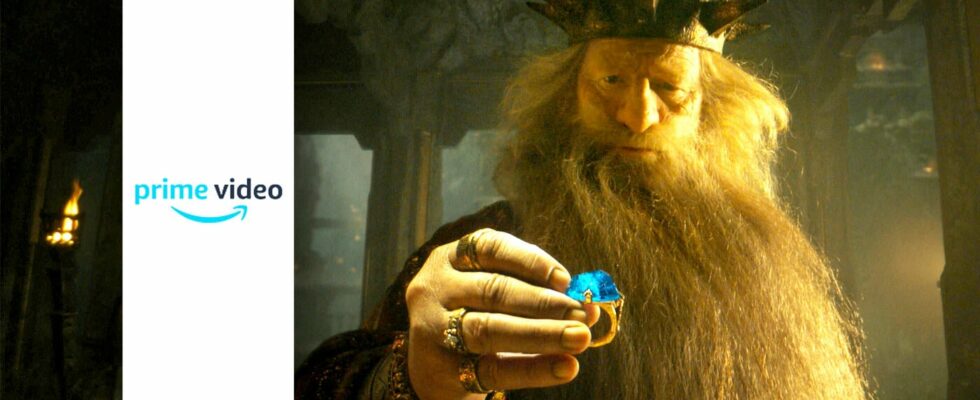In the 5th episode of season 2 of The Lord of the Rings: The Rings of Power, the 7 Rings of the Dwarves in focus. After the 3 Elven Rings, they are the dangerous next step on the path to the 20 Rings of Power, which the showrunners have already explained in more detail.
The Dwarven Rings of Power explains: “Seven the dwarf rulers in their halls of stone”
In episode 5 of season 2 of the Lord of the Rings series, the seven newly forged dwarven rings have reached their destination and King Durin III immediately uses his blue jewel to To solve the light problem of Khazad-dûmWith the ring on his finger, he senses what the stone singers are no longer capable of:
He recognizes where new shafts can be dug without the risk of collapse – even if his son Prince Durin IV (Owain Arthur) warns against working on the deep foundation walls of their homeland. The risk pays off (initially) and the dwarven kingdom once again brings the sun’s rays back for plant cultivation. The danger of starvation is thus averted, but a new threat is conjured up.
However, the new danger only becomes apparent gradually: Durin III invites messengers from the other six dwarven kingdoms and confronts them with a greedy demandThe other dwarf rulers only receive rings if they give him half of their shares in their mines. Shortly afterwards, a “ring tax” is introduced for the common dwarf people, whereupon goods suddenly cost twice as much. Prince Durin IV (Owain Arthur) is not impressed by this new behavior of his changed father worried. However, ringsmith Celebrimbor (Charles Edwards) can no longer help him during his visit to Eregion – or even admit to a mistake.
In The Silmarillion *, Lord of the Rings author JRR Tolkien describes that Sauron subjugates the dwarves with the seven rings of power wanted, but this was relatively immune to his influence Their natural resilience and stubbornness removed them from his dark control. Nevertheless, the rings promoted the negative characteristics of their wearers, who were given a longer life by the jewelry, but also a increased greed for treasureswhich ultimately led to their ruin. For example, the hoarded gold attracted dragons, as in the case of King Thrór in the mountain of Erebror, to which Bilbo Baggins later sets out.
The Dwarf Rings in the Lord of the Rings series prepare two disasters
At the end of episode 3, The Rings of Power clearly shows how Sauron (Charlie Vickers) in his new form as Annatar touches the dwarven rings, thus corrupting them. However, they are only one step in his plan to create nine human rings – and ultimately on the way to his ring of rulership. The experiments with blacksmith’s assistant Mirdania (Amelia Kenworthy) in the invisible world and Celebrimbor, who is finally reluctantly persuaded to help, show the progress of his plan, which showrunner Patrick McKay also explained to Techradar:
We wanted the rings to change with each group increasingly evil The dwarven rings have a slightly eerie and seductive quality. The rings of men even more so.
If the Dwarf Rings are only one step on the path to ultimate evil, every Lord of the Rings fan can already imagine the first approaching catastrophe: The Human Rings will corrupt their weaker wearers even more than the Dwarves and eventually the Nazgûl, i.e. Ringwraiths create.
The second catastrophe, which was prepared in season 1 and already revealed in the second season 2 trailer, is already shown in episode 5: the renewed Awakening of the BalrogDisa (Sophia Nomvete) not only feels the bad influence of the ring and makes her husband Durin promise never to wear it. She also feels the malice of the Balrog as she descends into the depths. Is his destructive rage in Khazad-dûm (aka Moria), as we later see it during Frodo’s journey through the mines, also part of Sauron’s plan? Galadriel would certainly say yes, as she sees the influence of her enemy on every corner of Middle Earth anyway.
The Rings of Power in the podcast: Is season 2 of the Lord of the Rings series worth watching?
After a two-year break, Amazon’s big fantasy series The Lord of the Rings: The Rings of Power is back. We discuss what makes Season 2 different and whether the first three episodes are convincing.
At this point you will find external content that supplements the article. You can display it and hide it again with one click.
After the revelation of the villain Sauron, the cards in Middle Earth are reshuffled. Esther and Mario view the result of the second season with very different perspectives. A spoiler-free first podcast part is followed by a series review with a more in-depth Lord of the Rings analysis.
*The links to Amazon’s offers are so-called affiliate links. If you make a purchase via these links, we receive a commission.
